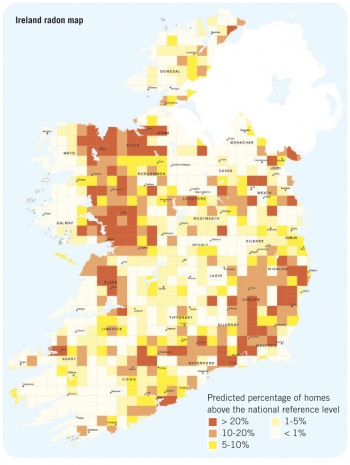CANCER
The role of GPs in the prevention of harm from radon
Radon is the second most common cause of lung cancer after smoking
December 7, 2012
-
Radon is a natural cause of lung cancer. Of the 1,910 cases of lung cancer per annum in Ireland,1 250 are estimated to be caused by radon.2 These lung cancer cases could be prevented by stopping radon getting into or accumulating in homes and workplaces.
Ireland is a high radon area; with the eighth highest average indoor radon concentration in the world.3 The Radiological Protection Institute of Ireland (RPII) Radon Map for Ireland (see Figure) shows the predicted radon risk by area.4 Only 5% of Irish homes have been tested for radon.
The risk of lung cancer from radon is related to the radon dose and personal smoking history. The World Health Organization recommends reducing population exposure to radon as there is no safe dose.
Prevention is better than cure
The installation of a radon barrier in buildings provides long-term passive protection from radon. Studies in Ireland confirm that radon barriers reduce radon in the home by 50%. The most cost-effective approach is to install a passive radon barrier to all newbuilds, irrespective of whether the house is located in a high or low radon risk area.5 This would significantly reduce the average population dose.
The RPII recommends testing and remediation of the already built environment. In Ireland, the Office of Public Works has tested, and remediated where indicated, all public schools and is in the process of testing all State workplaces. For private buildings, responsibility to test and remediate rests with the owner.
The RPII website (www.rpii.ie) has details on how to apply and pay for a radon test, and lists the measurement companies in Ireland. A home radon test costs about €50.
Smoking cessation mitigates the risk from radon
Tobacco is the most important lung carcinogen; radon is the second most important. Radon, a radioactive gas, is a risk factor for lung cancer due to its direct local effect on the lung.
Tobacco also has direct effects on the lung. The risk of radon-induced lung cancer is 26 times greater in smokers than non-smokers:
- A non-smoker with little radon exposure is at least risk
- A non-smoker with some radon exposure is at some risk
- A smoker with little radon exposure is at increased risk
- A smoker with radon exposure is at greatest risk of lung cancer.
- All cost-effective smoking prevention and cessation interventions should be actively promoted in high radon areas.
What GPs can do to reduce the risk of lung cancer from radon:
Be informed. Check whether your practice area is a high radon area2
All adult patients: Brief intervention for smoking cessation is even more important for smokers who live in high radon areas and might be actively promoted
Advocate the primary prevention of radon exposure by installation of a radon barrier in all newbuilds and all extensions of existing building stock.
Patients exposed to high levels of radon
Past exposure cannot be undone. GPs can advise that reducing the radon concentration and quitting smoking will immediately reduce the risk of lung cancer.6 Quitting smoking reduces lung cancer risk from radon more than does reduction of radon exposure itself. Current smokers can very significantly lower the risk of lung cancer by stopping smoking now.
Radon damage to human tissues is not detectable by routine medical testing. Technologies such as CT screening also involve radiation exposure and are not indicated.
Radon is not irritating to the lungs in the conventional sense. It does not cause or increase the risk of asthma, nor is it associated with other common respiratory disorders.
In patients who have been diagnosed with lung cancer – especially if non-smokers – the GP might consider whether radon exposure could have caused or contributed to development of the cancer. The GP might advise that the home be tested for radon. If a high radon level is found, remediation is recommended to reduce ongoing risk to other family members/residents. The RPII website has remediation guidance.7
Resources
The HSE and RPII have produced a health information leaflet8 for those with concerns following radon exposure, which the RPII will issue to householders and employers as indicated.
Radon is the greatest source of radiation exposure to the public in Ireland. An inter-agency group mandated by Government to develop a national radon strategy, to reduce the number of cases of lung cancer in Ireland due to radon,9 is due to report in November 2013.
References
- Annual average number of lung cancer cases 2007-2009, National Cancer Registry Ireland. www.ncri.ie
- Health Risks due to Exposure to Radon in Homes in Ireland – the Implications of Recently Published Data. Joint Statement by the Radiological Protection Institute of Ireland and National Cancer Registry of Ireland September 2005 Available on www.rpii.ie
- World Health Organixation. Handbook on Indoor Radon – A Public Health Perspective 2009. www.who.int
- The radon map can be viewed in detail on the RPII’s website www.rpii.ie
- Gray A, Read S, McGale P, Darby S. Lung cancer deaths from indoor radon and the cost effectiveness and potential of policies to reduce them. BMJ 2009; 338: a3110 doi:10.1136/bmj.a3110
- Quit.ie – Help information and advice on how to quit smoking from the HSE www.quit.ie
- Understanding Radon remediation – a Householder Guide, www.rpii.ie
- Radon and your Health. www.rpii.ie (Pending)
- Radon gas in Ireland - Joint position statement by the RPII and HSE. April 2010 www.rpii.ie

